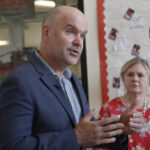Sitting opposite each other at the long table beside the window, Olivia Kinkelaar and Olivia Hendren worked quietly, hands dipping into the bright green water bucket on the table between them.
Sitting before the two girls was an assortment of small clay pieces – a bird, a ball, a cat, a starfish, all the fruits of their labor. The water in the bucket was to keep their clay wet as they worked.
“If you wet the clay a bit, you can add the wings,” their teacher, Lori Middleton, told them, as she moved through the room.
Using clay-building techniques that date back to the world’s first potters – pinching, coiling, and slab building, the class of 20 students, age 11 to 15, had built masks, pots and trays during the week. Once those pieces were fired in the museum’s kiln, the students would glaze them, and fire them again.
For the masks, the theme was the ocean. That inspired Hendren to drape tentacles over the top of her mask and a starfish over one eye. Kinkelaar created a wave curling over hers.
But on this particular afternoon, the two Olivias, and the class, were making whistles – all sizes, shapes and kinds, but real-life, working whistles.
The gentle hoots and toots of different whistles ranged up and down the musical scale.
Making a clay whistle is simpler than it sounds.
First, the artist forms a pinch pot; almost any size and shape will do. The chamber size will be one of the factors that dictates the whistle’s tone.
Next the artist makes two holes. A Popsicle stick is the perfect tool to make the flat blowhole.
Then a dowel or needle is used to push a smaller, wedge-shaped hole on top for sound to come out.
Kinkelaar and Hendren, both 13 years old and students at St. Edward’s, are clearly on the same wavelength when it comes to making art. This is their second year taking ceramics with Lori Middleton, art teacher at Storm Grove Middle School.
“They are both meticulous workers. Patient, never rushing, they think it through ahead of time and work diligently,” said Middleton, who has taught art for 12 years, and the past 5 summers at the museum.
Once the students finished their whistles and put them aside to dry, they cleaned their work areas and stepped outside for a snack.
After snack, Middleton held up two face jugs made from pinch pots that she had found at a flea market in North Carolina.
“You can make your jug any size you like but you want to give it a real face,” she said. “And I should warn you, this clay doesn’t smell so good.”
As assistants passed out the dark grey clay, the artists, apparently undaunted by any odor, plunged in and began to knead.
The Summer Art Camp offers a variety of art classes for ages 2 to 15. Classes run through Aug. 6 with new ones starting every week.
For more information, or to register for a class, call (772) 231-0707 or visit www.VeroBeachMuseum.org.






